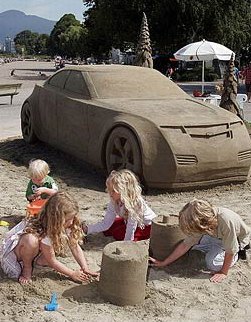Volt Birth Watch 129: Extended Range Explained. Or Not.
C. Douglas Weir wrote GM about the Chevy plug-in electric – gas hybrid Volt’s extended range feature. GM wrote back. First, Doug…
My confusion is the issue of what, exactly, happens as the range is exhausted for battery-only propulsion. I keep seeing the phrase: “a small engine-generator creates additional electricity to extend the range of the Volt several hundred additional miles” or something to that effect.
So, what exactly does this mean? Is the performance of this small engine-generator adequate for cruising down interstate highways and up long steep grades? Does the Volt become underpowered with this out-of-battery charge scenario? Say you were driving a couple hundred miles to the mother-in-law’s and you own a Volt and a G-6. Would the Volt be left at home because it would be unpleasant to drive in extended range mode? Or would it drive just fine on the small motor-generator with performance similar to a standard small four cylinder midsize car?
Also, the wording implies that the drive train would remain electric, with the motor-generator producing enough current to power the electric motor(s) through or around the battery stack. So is it correct that there is no direct drive from the engine to the wheels…rather it is a serial hybrid like a diesel locomotive when the battery is exhausted?
I hope you can clear this up for me. Any added information would be much appreciated.
Answer after the jump.
Hi Douglas. Thanks for the inquiry. Let me explain in simple terms. For more detail, check out media.gm.com/volt and look in the Technology tab. Lots of info there.
The Volt has two modes of operation – EV and Extended-Range. The engine generator seamlessly operates when the energy level in the battery is “depleted”. Although the driver will see the battery as empty, energy in the battery is really sustained or held in what we call a “buffer zone”. Think of it like a home generator when your power goes out. It starts to create additional electricity to power the car hundreds of miles. The electricity is fed to an electric drive unit, which powers the car. There is no mechanical connection between the engine generator and the wheels. As long as you stop and refuel the generator (like in any conventional car today), you can drive from coast-to-coast until you can stop and plug-in to recharge the battery. As far as performance, there is no compromise when in Extended-Range mode. The battery and engine generator work together when peak performance is needed most, such as driving up inclines.
Hope this helps.
Dave
Dave Darovitz
More by Robert Farago
Latest Car Reviews
Read moreLatest Product Reviews
Read moreRecent Comments
- MaintenanceCosts RAM! RAM! RAM! ...... the child in the crosswalk that you can't see over the hood of this factory-lifted beast.
- 3-On-The-Tree Yes all the Older Land Cruiser’s and samurai’s have gone up here as well. I’ve taken both vehicle ps on some pretty rough roads exploring old mine shafts etc. I bought mine right before I deployed back in 08 and got it for $4000 and also bought another that is non running for parts, got a complete engine, drive train. The mice love it unfortunately.
- Statikboy I see only old Preludes in red. And a concept in white.Pretty sure this is going to end up being simply a Civic coupe. Maybe a slightly shorter wheelbase or wider track than the sedan, but mechanically identical to the Civic in Touring and/or Si trims.
- SCE to AUX With these items under the pros:[list][*]It's quick, though it seems to take the powertrain a second to get sorted when you go from cruising to tromping on it.[/*][*]The powertrain transitions are mostly smooth, though occasionally harsh.[/*][/list]I'd much rather go electric or pure ICE I hate herky-jerky hybrid drivetrains.The list of cons is pretty damning for a new vehicle. Who is buying these things?
- Jrhurren Nissan is in a sad state of affairs. Even the Z mentioned, nice though it is, will get passed over 3 times by better vehicles in the category. And that’s pretty much the story of Nissan right now. Zero of their vehicles are competitive in the segment. The only people I know who drive them are company cars that were “take it or leave it”.


































Comments
Join the conversation
No, the paper I linked to explains that once the car starts driving the battery state of charge will generally fall, until it reaches the minimum level, roughly 30% capacity. From there on the engine will maintain the charge at around that 30% level, while using the battery as a buffer to provide acceleration and absorb regen. The engine runs at a few fixed points, the battery provides or absorbs the difference in power between that power and the demand power for the car. The only way to restore the full charge in the battery would be to push the car down a very long hill (joke) or plug it back into the grid. Incidentally the PR droid's response was accurate, and he did advise the original enquirer to read further on their site. Not too sure why that exchange got such a negative reaction.
DougW hit the nail on the head. How many of you guys have any experience with electric powered vehicles (golf carts, electric scooters, LSEV's, etc)? I'll bet its under 5%. For those that do already know that a electric vehicles that operated "adequately" on full charged batteries on relatively flat and level ground with a median load perform abysmally when low on charge (